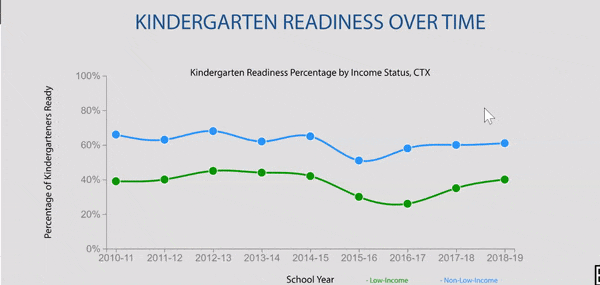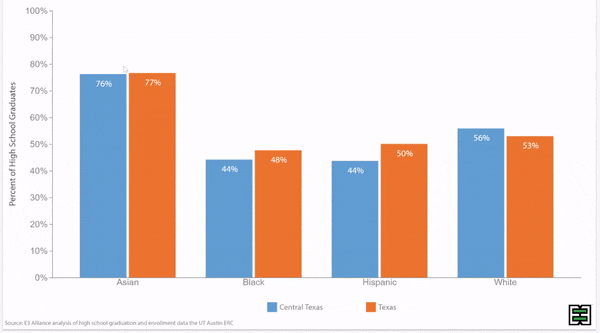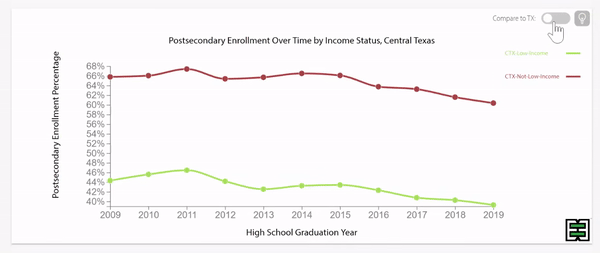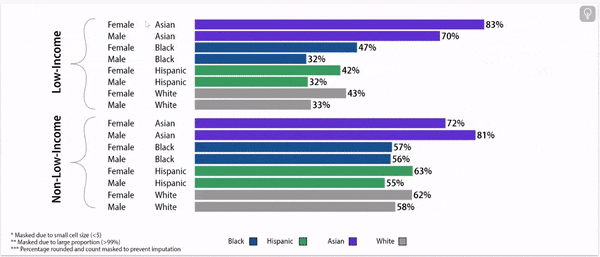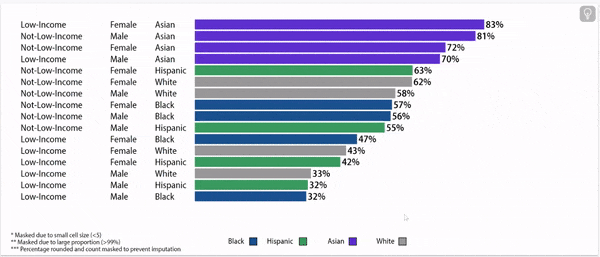Math Pathways | Middle School Math Profile
The pathway to complete college-aligned coursework in high school starts early for most students, usually in elementary or middle school. Therefore, E3 focused on math course taking patterns for students in middle school as a leading indicator that students will be prepared to take four years of math in high school, with the fourth year aligned with college standards.
In 2017, E3 Alliance studied the most recent cohort of eighth graders and looked back at their fifth grade STAAR test scores. The research found that students who scored in the top forty percent of all STAAR test takers experienced high rates of success on advanced middle school math pathways. At the same time, fewer than 33% of Black students, 46% of Hispanic students with STAAR scores in the top 20% of all Texas STAAR takers in fifth grade, who attended eighth grade in Central Texas, had completed Algebra I by eighth grade. Unfortunately, research by E3 Alliance showed that decisions to move students onto those pathways did not seem to be based on any objective measure of their capacity to succeed, but instead reinforced biased perceptions of students’ math aptitude.
Jump to: Source and cohort information about this data.
2023-24
46%
5,894 / 12,680
El Paso
Middle School Algebra I Completion Rate
2023-24
42%
11,703 / 27,995
Central Texas
Middle School Algebra I Completion Rate
Middle School Algebra I Completion has Increased in Last Decade
Disparities in Middle School Algebra I Completion by Household Income Have Not Decreased in Texas
Disparities in Middle School Algebra I Completion by Race Persist Over Time
Digging Deeper: Gender, Income, and Race Play a Role in Middle School Algebra I Completion Rates
Middle School Algebra I Completion Rates, 2024
Identifying Promising Practices In Math Pathways
Through partnership with school districts in our region, we have been able to close the equity gap between White and Black high performing Central Texas students by over 85% since 2017. For more information on scaling this success statewide, click here. The chart below shows what percentage of students who scored in the top two quintiles on their fifth-grade math STAAR completed Algebra I by eighth grade, by cohort, over time. How equitable is your region in ensuring all high-performing students have access to advanced courses?
About this data:
E3 Alliance relies primarily on data from the University of Texas Education Research Center (ERC). This data allows for a longitudinal understanding of middle school Algebra I in relation to their fifth grade STAAR performance. This data pertains to 8th grade students who were enrolled within the state of Texas at the end of a given school year. Data on high performing students is based on fifth grade STAAR results, regardless of where in Texas the student completed fifth grade. Students who did not attend fifth grade in Texas are not included in that portion of the analysis.
Following are items to note:
The year of the data represents the year that a given cohort finishes 8th grade. Students who took Algebra I prior to that year, who are in that 8th grade cohort are reported in the year they complete 8th grade. The data presented are the most recent data available in the Texas Education Research Center.
Outcomes that reference data from 2021, 2022, or 2023 do not include San Marcos CISD, due to a data discrepancy.

